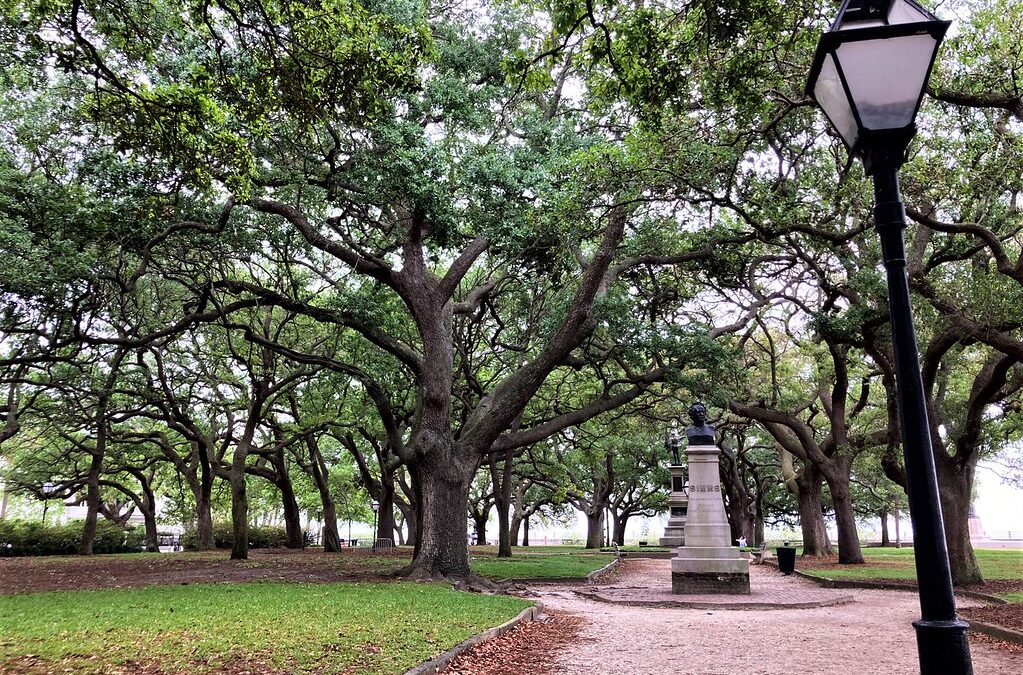By Katie Finch, Senior Nature Educator
I recently visited Charleston, South Carolina, a city full of history, tourist attractions, and beautiful buildings on the Atlantic Coast. We spent much of the day walking around the city. I’m not accustomed to the crowds, traffic, and city noise. After a day of walking, I was tired. I was grateful that our ramblings took us to White Point Garden, at the tip of the peninsula looking out toward the ocean.
Majestic live oak trees dominate this park. Their branches, covered in green leaves, stretch wide and create a continuous canopy overhead. Aside from the trees, the park appeared sterile. There was an understory of mowed grass and gravel paths. The occasional historic monument rose into the understory. While beautiful, it was not a rich habitat. Or so I thought.
While resting on a bench, two egrets (Great Egrets, I think) caught my eye, their large white bodies landing in the treetops. I walked over for a closer look and noticed dark shapes among the branches. Maybe dense clusters of leaves? Nope. Those shapes had feet! And they moved. It took me a few more minutes of watching and puzzling it out. But I figured out they were Black Crowned Night Herons.
Like a hidden picture challenge, the longer I looked, the more I saw. There were at least 25 birds, if not more, in the trees. And some of those dark shapes were nests. It was a heron rookery. But all was silent in the colony of breeding birds. As their name implies, these birds are most active at night. If I angled my head just right, I could see their heads and bodies merge as they rested. At night, they feed along the shore, searching for just about any creature in the mud and shallow water.
As I excitedly observed birds, others park visitors walked by unaware of the creatures living out their life above. This knowledge felt like a secret. Part of me loved having this secret. There was pride and gratitude at having made this discovery. There was a feeling of exclusiveness of knowing something that others didn’t know. But a larger part of me wanted to shout this from the rooftops for all to se. There was an entire colony of birds, not just perching for a moment but taking shelter, feeding, nesting, and raising young among this heavily human-built landscape.
This is the first time I had ever seen this bird – at least that I’ve been able to identify. Black Crowned Night Herons are a common bird in wetlands around the Americas. Reflecting on this, I pondered on two big questions.

The first question: what happened after I left? A few pale green eggshells were already on the ground, a sign of the cacophony of young soon to fill this space. All those eggs are going to hatch, and the young will eventually climb out of the trees and wander around on the ground until they can fly. I think it would be marvelous and am sorry I am missing it. I’m sure some others think it a messy inconvenience.
What if these animals were more than a one-time sighting but more like fellow living beings whose births, changes, and deaths we not only noticed but celebrated and honored?
The second thing I pondered was about how we make these discoveries. If I found this, how many other things do I simply not notice? The answer may seem simple. Pay attention. But it is more than that. It’s taking the time to look after you think you’ve seen it all. I didn’t see the feet on those dark shapes in the tree at first glance. It took at least a minute or more of just looking.
It is also more than just seeing. It is also knowing what you are seeing. And that knowing is driven by curiosity. Whether you know it in the moment from a bank of knowledge that you’ve stored up or figure it out later, curiosity motivates us to find things out. And when I knew what these footed blobs were, I could learn more about who they are, but also how and why they are too. I can fit them into the larger story of that place.
I think what so excited me about the night herons was the fact that they were unexpected. We often compartmentalize. The city is for humans and the wilderness is for animals. But observing nature can be done almost anywhere because nature is everywhere. And it is every day, not just on vacation.
The two large urban areas in the communities ACNC serves – Jamestown, NY and Warren, PA- are rich with nature. They both have waterways in the city, and both are full of majestic trees, some as large as the oaks in Charleston.
Nighthawks, another nocturnal bird, nest on top of buildings in cities. I’ve heard their nasal “peent” call as they feed on insects while flying over the buildings of both Jamestown and Warren. I’ve watched Blue Jays hiding acorns in the mossy roof of a garage. I’ve photographed a Bald Eagle nest just outside of Warren. And I’ve startled a beaver behind the Jamestown power plant.
All of these animals are living out their lives around us. These are just a few nature sightings in both these spaces. I’m certain others have more stories. And so can you. It just takes curiosity and a long look around.


Recent Comments